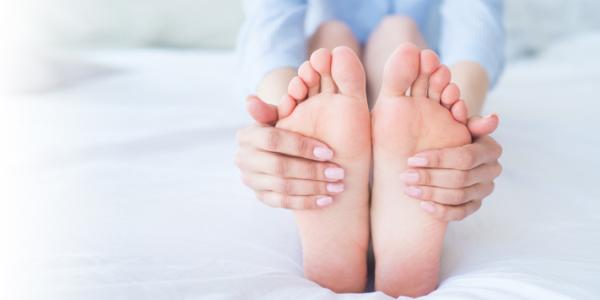
The foot is literally your body's foundation. It supports your weight, helps you balance, and withstands enormous pressure with every step you take. Keep your feet healthy with some of these tips.
Each foot is made up of 26 bones, 33 joints, 107 ligaments, and 19 muscles and tendons. That's a lot of interconnected moving parts, making biomechanics a critical aspect of treating foot conditions. The foot and ankle must work in tandem. Even the most common minor toe deformities can impact walking, balance, and weight-bearing. No wonder 75% of us will experience foot or ankle problems at some point in our life. That's why, just as you care for your teeth by flossing, brushing, and seeing your dentist regularly, you must care for your feet. After all, you depend on them to get you through the day, every day. They deserve a little TLC.
Twelve Tips for Healthy Feet
- Wash your feet every day in lukewarm water. Rinse and dry them thoroughly and wear clean, dry, well-fitting socks that don't bunch up or fit too tightly around the ankles or calves.
- Moisturize your feet every night to prevent itching or cracking. Don't put lotion between your toes, which can lead to athlete’s foot.
- Check your feet regularly. Look for blisters, small cuts, cracked skin, or peeling skin between your toes. If you are diabetic, it's important to do this daily and report any changes in your feet to your doctor.
- Keep your toenails trimmed. Don't cut them too short which could lead to ingrown toenails. Instead, cut toenails straight across and then file down the edges.
- Always wear well-fitted shoes that support your feet and ankles to minimize the risk of twisting an ankle and to avoid blisters.
- Follow these tips for buying shoes:
- Shop for shoes at the end of the day when your feet tend to swell.
- Try shoes on with the socks you plan to wear with them.
- Walk around, jump, lean or jog in place to see how the shoe feels when you move. Uncomfortable shoes can damage your feet and throw your body out of alignment.
- If one foot is slightly bigger, buy the size that fits the larger foot.
- Check that there is a thumb's width between the end of your big toe and the tip of the shoe and that the ball of your foot fits comfortably in the widest part of the shoe. Don’t buy shoes you have to "break in".
- Ask a physical therapist or podiatrist if you need orthotics and bring them with you when you try on shoes.
- Keep your blood sugar under control so you don't develop type 2 diabetes which can cause nerve damage, loss of sensation, and reduced blood flow in your feet, and raise your risk of infection.
- Protect yourself from athlete's foot and infected toenails by wearing moisture wicking socks. If your feet sweat, change your socks as soon as possible.
- Wear heels sparingly and choose a chunky, broad-based heel. High heels tip you forward, changing the position of the foot with relation to the ankle and can lead to chronic knee, hip, or back pain.
- NEVER share shoes or pedicure instruments.
- Don't perform "DIY surgery" on blisters or ingrown toenails. Visit a podiatrist instead to avoid the risk of infection.
- Don't shave callouses. Instead, use a skin softener and a pumice stone to help remove them gradually.
- Treat your feet by massaging them or rolling them over a tennis or golf ball. Lie down and elevate your legs to stimulate circulation.
Podiatrist or Orthopedic Surgeon?
If 75% of Americans will eventually develop a foot and ankle problem, there's a good chance you will too. So, who do you call? A podiatrist or an orthopedic surgeon who sub-specializes in feet?
The most significant difference between an orthopedist surgeon with a sub-specialty in the foot and a podiatrist is training. Orthopedic surgeons only starts to specialize after 4 years of medical school. Then, they go through 5-6 years of orthopedic training. At that point, an orthopedist can choose to work as general orthopedic surgeon or spend another year in sub-specialty training. As a medical doctor, an orthopedist is trained to understand the entire body, including the bones, muscles, ligaments, tendons, and joints. An orthopedic foot specialist has the training to treat complex lower extremity conditions that originate in the knee or lower back.
Podiatrists know from the very beginning that they are specializing in the foot. They go to 4-year podiatry school followed by a 2 or 3 year residency. Compared to orthopedists with a sub-specialty in foot surgery, podiatrists start their careers with more real life experience. They too can obtain surgical training, often alongside orthopedists. Both podiatrists and orthopedic surgeons treat parts of the foot and ankle that pertain to the bones, soft tissues, and joints. However, a podiatrist is also trained in biomechanics and dermatology of the foot and ankle. If you're looking to be fitted with orthotics or an ankle brace or you need a caregiver who has expertise in diabetic foot issues, a podiatrist is the right choice.
To find a doctor who is right for your needs, click Find a Provider.
This article first appeared in the April 2023 edition of the HealthPerks newsletter.

